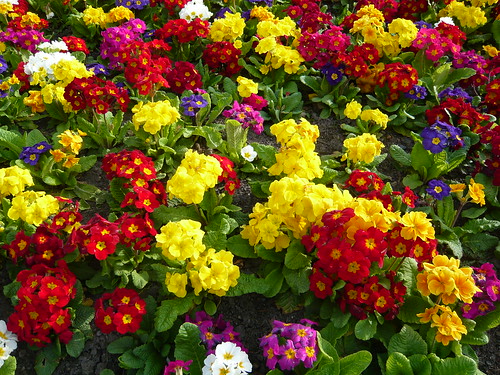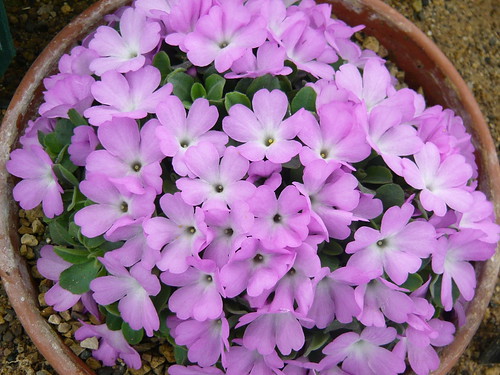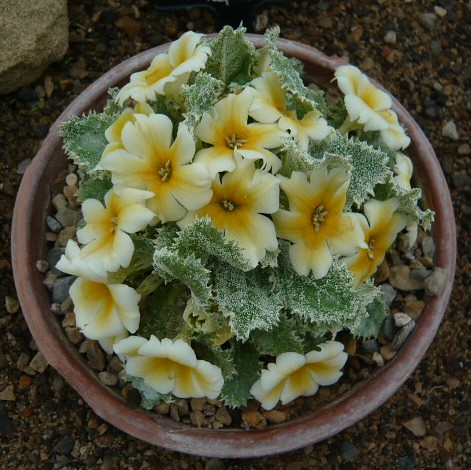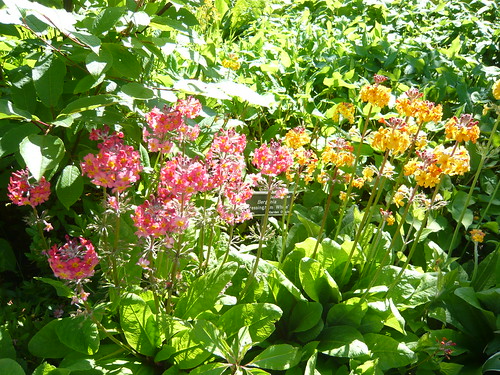Primula & Polyanthus Seed Sowing Secrets
There should be no great secrets to sowing seeds of one of our favourite genus the Primula. However with in excess of 600 species and 30 different groups or sections you need to be on top of your seed sowing game.
Secrets of Timing when Sowing Primula
- Nature sows seeds soon after flowering. If it is good for mother nature it likely to be good for gardeners.
- On the other hand most seed can remain viable for several years. Keep the seed in packets in a screw-topped jar and store in the cool & dark preferably in a fridge
- If you sow before the end of May the plants have time to develop before winter.
- Sowings can be made up to the end of July as long as you keep the seed compost cool and moist.
- The later you leave it the more difficult it is for small plants unestablished Primulas through a winter season.
- Primula seeds germinate best when they are fresh and ripe.
- Alpine Species generally benefit from natural freezing and thawing to get them germinating so it’s important to sow as early as possible.
Secrets of How to Sow Primula
- Sow seed thinly on surface of compost and gently firm.
- Seal in a polythene bag or cover with a piece of glass to retain humidity and place in a shady spot.
- Do not exclude light which helps germination but remove the cover and provide cool light as soon as the seed germinates.
- Keep the soil damp but not wet and allow most Primulas to germinate in humid conditions.
- Germination generally takes from 10-30 days but some species are far slower.
- Use good quality open seed compost. Primula do not like strong chemicals in compost.
- Primula roots need air to grow and develop. If the compost is too fine watering can drive all the air out.
- Too much heat can kill Primulas as they germinate. Never use a heated propagator. Ideal seed sowing temperatures are up to 15 degrees C.
- Primula seedlings need light and air to germinate
- After germination cover the chitted seed with a fine layer of vermiculite or sieved compost to anchor the roots. Do not be in a hurry to prick out – give the plants chance to develop good roots.
Seed Sowing Secrets of Special Primula
- The best time to sow polyanthus, acaulis and auricula is between February and April
- Primula Sieboldii are best sown from November to January and left outside. They may take six weeks to germinate.
- Double primroses, hose-in-hose, jack-in-the-green and auriculas are slower to germinate.
- Primula wanda seeds can be sown from February to July for flowering the following year.
- Primula auricula like good drainage and fresh air.
- Primula marginata grow in limestone regions. Crock seed pots with limestone.
- Primula vernalis are renown for growing sports. Check out yor seedlings for something special.
- Primula whitei aka P. Bhutanica like acidic soil and set good amounts of seed.
Secrets After Sowing Primula
- Self sown seeds should be given one flowering season to prove themselves. The worst flowering plants may need to be culled and composted.
- Primulas are classified as to their origin. European, Asiatic or American this may give you a clue as to the preferred sowing and growing conditions.
- Many Primulas dislike root disturbance.
- Seeds may germinate erratically so leave the seed pans after pricking out as you may get late developers. For that reason it may be worth sowing small quantities of seed in each pot.
- Few Primulas will survive hot summers baking in the sun or indoors in stuffy conditions.
- Keep cool and moist and you will be rewarded with crisp, sturdy foliage to see plants through winter.
- Primula often put on an autumn spurt of growth to replace leaves that die-back after flowering.
- For growing in pots, clay rather than plastic helps control watering and evaporation through the sides reduces heat.
- Pot primulas need little watering during winter as they are prone to rot due to a reduced root system activity at that time of year. Increase watering in early spring to stimulate growth.
More Primula Secrets
- Primroses, Polyanthus, Cowslips, Oxlips and Ariculas are all part of the Primula family.
- The family is fecund and often cross fertilises so seed seldom come true unless great care is taken with pollination.
- ‘Florists’ were the early growers and breeders of primula before the name Florist became generic for one who sells flowers
- Sand is generally colder and wetter and clammy in winter so if your soil is sandy add some humus.
- After flowering or division, brash Primulas may appreciate a ‘thankyou feed’. Alpine varieties will probably manage without.
- Pot up a garden plant and bring it indoors to flower. Then replant in the garden.
- Double Primroses like a partially shaded position and large quantities of organic matter.
- Rosebud Primroses do not set seed. Plant will keep producing blooms in an effort to set seed.
- Strong flowering ans seed production can exhausts Primulas and they need extra feeding and watering with a weak solution of high potash or tomato fertiliser from when buds first appear.
Resources
Primula – Alpines and Pot Plants
Get Free Primula Plants by Division
Growing Primrose
Growing Excellent Auriculas
Primula Family – Selected Garden Pictures
More Primula seeds from Thompson & Morgan
My Seeds Arrived 14 April From Chiltern Seeds
Primula alpicola
Found only in the Tsangpo river basin in south-eastern Tibet at an altitude as high as 15,000 ft., where it grows in marshy ground and damp meadows, is this beautiful and graceful plant with long stalks bearing one or two umbels of numerous, fragrant, broad-funnel-shaped flowers, each an inch across, that can be white, yellow, purple or violet. 6-20 ins. £2.99 per packet
Primula chionantha
From Yunnan in southern China comes this superb Primula forming an upright tuft of thin, whitish-green, strap-shaped leaves, and bearing in spring very stout stems with up to four umbels of numerous, yellow-eyed, white flowers. These have a delightful fragrance of vanilla. 15-30 ins. £3.09 per packet
Primula flaccida
Found in rocky pastures and open pine forests at 11,000 ft. in the Himalayas of Szechwan and Yunnan, this is a glorious Primula. Forming neat rosettes of narrow, sparsely hairy leaves, it bears in summer beautiful pyramidal spikes of densely nodding, lavender-blue, bell-shaped flowers. As Reginald Farrer says, this plant has a glory surpassing all its kin. 12 ins. £3.25 per packet
Primula malacoides, Mixed Fairy Primrose short lived
A delightful and well known greenhouse Primula often sold in winter and spring as a house plant. The compact bushy plants are covered with dense clusters of open flowers just above the foliage, in various shades of red, rose, lavender and white. 8-12 ins. £3.19 per packet … Annual, Biennial
Off to practice what I preach sowing these Primula seeds
A bedding plant favourite the primrose family produces many great plants.
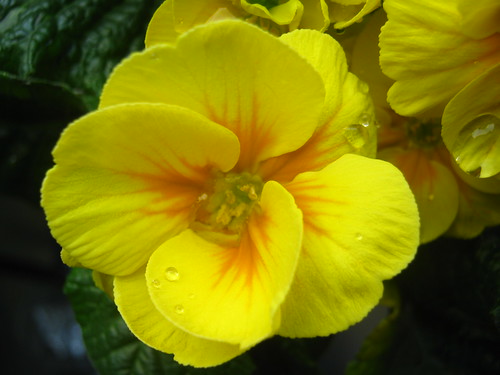
Primula is a genus of several hundred species of low growing, hardy, herbaceous perennials. Many varieties are easily grown from seed. Pacific Giants Flower in early spring and are suitable for Baskets, Bedding, Containers, Cottage Gardens or Patios .
Continuous blooming and gigantic in size with early spring flowers up to 2¾in they are available in a good variety of colours. Recommended for spring bedding, pots or naturalising in a sunny/half shady spot. Flowers .
Sowing Instructions
Sow spring to mid summer in good seed compost. Sow seed on surface of compost and gently firm. Seal in a polythene bag or cover with a piece of glass and place in a shady spot but do not exclude light which is beneficial for germination. Keep the soil damp but not wet. Germination usually takes 10-30 days at 15-18C (60-65F), higher temperatures can prevent germination. Once most of the seeds have come up, sprinkle a tiny amount of sieved compost over the roots to anchor them.
After sowing, do not exclude light as this helps germination.
As soon as you see the seeds starting to chit (germinate) lightly cover the seeds with vermiculite.
When seedlings are large enough to handle, transplant them into 7.5cm (3in) pots or trays.
Transplant when fairly moist and later plant out 9in apart in the autumn where they are to flower in good soil, sun or part shade’
Primula are available as seed in many mixes from Thompson & Morgan
In addition varieties of polyanthus icluding Golden Lace and scented varieties are also supplied by Thompson & Morgan
Top Ten Primula species worth growing from seed
- Primula auricula Douglas Prize Mix
- Primula denticulata Mixed
- Primula hybrida Arctic Mixed F1
- Primula japonica Miller’s Crimson
- Primula obconica Twilly Touch Me F1 Hybrid
- Primula veris
- Primula vialii
- Primula vulgaris Primrose
- Primula x Candelabra Hybrids
- Primula x Wanda
